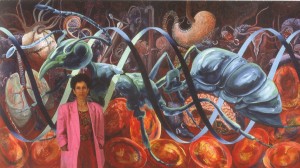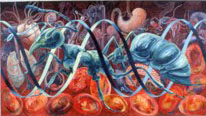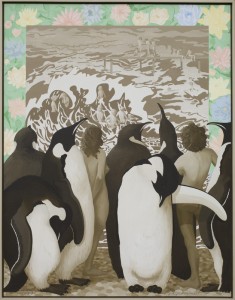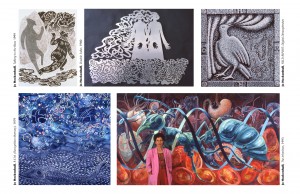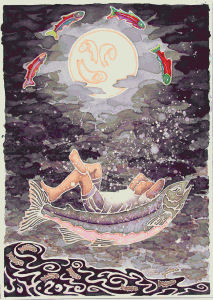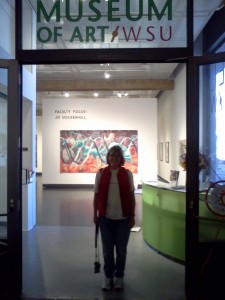The Inheritors: An Exhibition by Jo Hockenhull
We are embedded in the natural world inside and out, organs and bones; we are in and of the bird world, the animal world, the world of insects; some of those creatures are going to survive the human species, in the end because of our obliviousness to our place in the world.
That idea is a major theme of Jo Hockenhull’s career survey at the Washington State University Museum in Pullman, Washington. Hockenhull, a professor of art at Washington State University for many years, has roots in printmaking, but this exhibition demonstrates that she never stands still. Her work ranges from small prints to huge oil paintings, steel cut sculptures, works that evoke the arts and crafts movement in tones and density, and paintings that allude to the disjunctions of humans and the rest of the natural world using digitally generated images placed in the midst of expressive renderings of rats.
In The Inheritors, she focuses on giant ants, with DNA helixes winding through them. Below are large transparent eggs with fetuses. Behind the ants are accurate renderings of various organs, liver, heart, kidney. In her lecture Hockenhull spoke of how ants, who have captivated her for years, will survive after we are all gone. These huge insects are indeed the inheritors of our careless wasting of our complex planet.
Hockenhull’s watercolors are stunning. The early Penguin Nostalgia with a man and woman rendered with a sensuous contrapposto worthy of Botticelli, together with seven delightfully rendered penguins (obviously based on close observation of the behavior of these wonderful creatures), seem to be gazing at a display at an aquarium in which a turbulent sea tosses cherubs. The mid size scale of this work, makes it possible for us to feel as though we are also viewing this unusual display, although from a distance.
Many of Hockenhull’s ink drawings, done as illustrations for books, are small, with a subtle black and white decorativeness, have a strong force that counters the decorative qualities with charged purposefulness.
Yet another entirely different aesthetic is the imitation stone low relief paintings, many of them birds, another passion of the artist. She was inspired by low relief imagery in stone, but her reliefs, which can be independent square paintings, or a type of bas relief under a larger painting in a different style, all are her own personal interpretation of that ancient approach to imagery. (Upper right image below)
Hockenhull never stops exploring. I wished sometimes we could have seen more of a particular idea ( as in her Past Present Future series with the word Future crossed out, or the subtle series of paintings Sentinel Singers, inspired by Chinese funerary stele). Her interest in science comes through clearly in the large scaled xray series which were given a coherent display at the center of the exhibition. But frequently, chronology, media, and themes were broken up in the installation, disrupting our ability to follow ideas. With an artist of this intensity, that was not helpful. But nonetheless, the exhibition is an inspiration as a demonstration of the ways in which an artist can pursue multiple directions. So often today, we have the opposite, one direction, one style, one statement repeated over and over.
The theme in this retrospective is humans and nature, their interactions, their collisions, their contradictions, their connections. This recent watercolor, Beginner’s Creek, suggests one possibltity for our peaceful future, returned to the embrace of the natural world.
Get Pullman on your fall travel map and see this exhibition!
This entry was posted on September 10, 2012 and is filed under Art and Activism, Art and Ecology, Art and Politics Now, Uncategorized.

